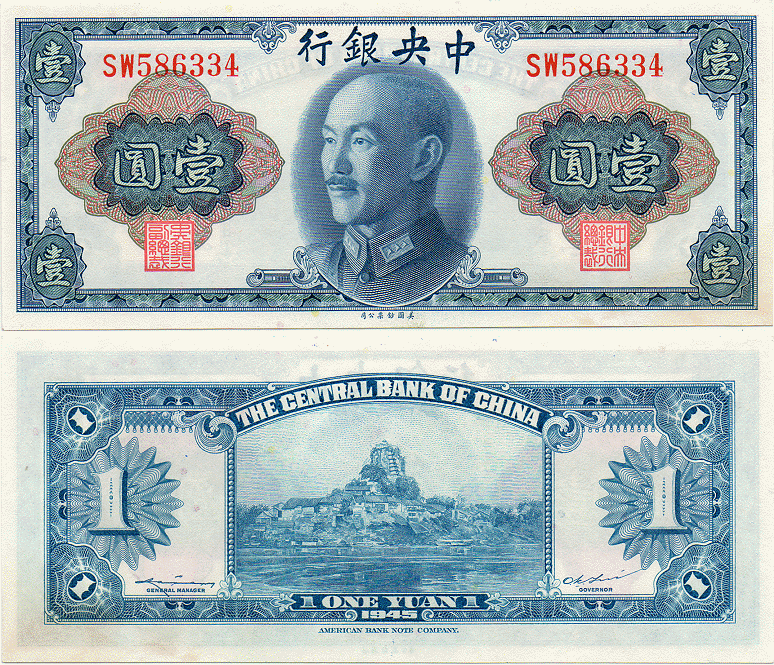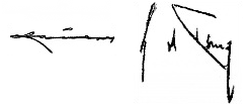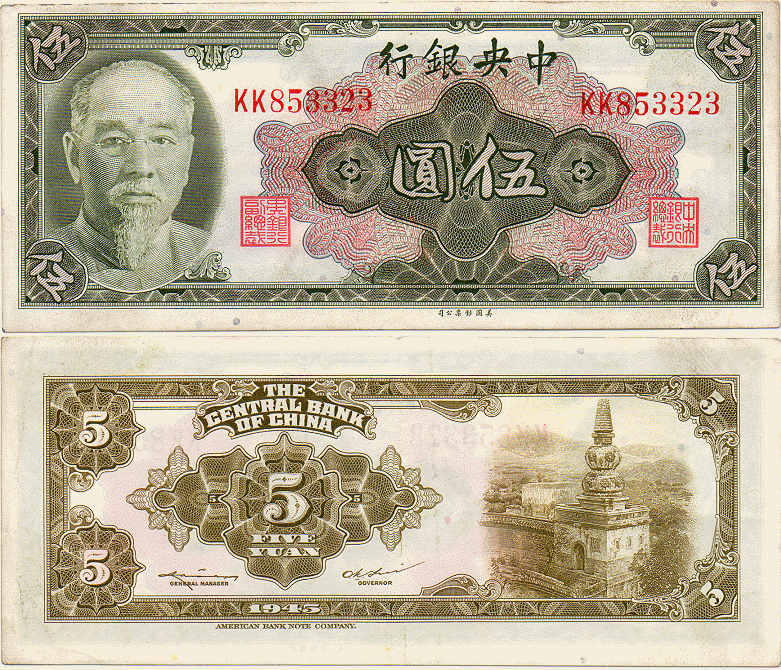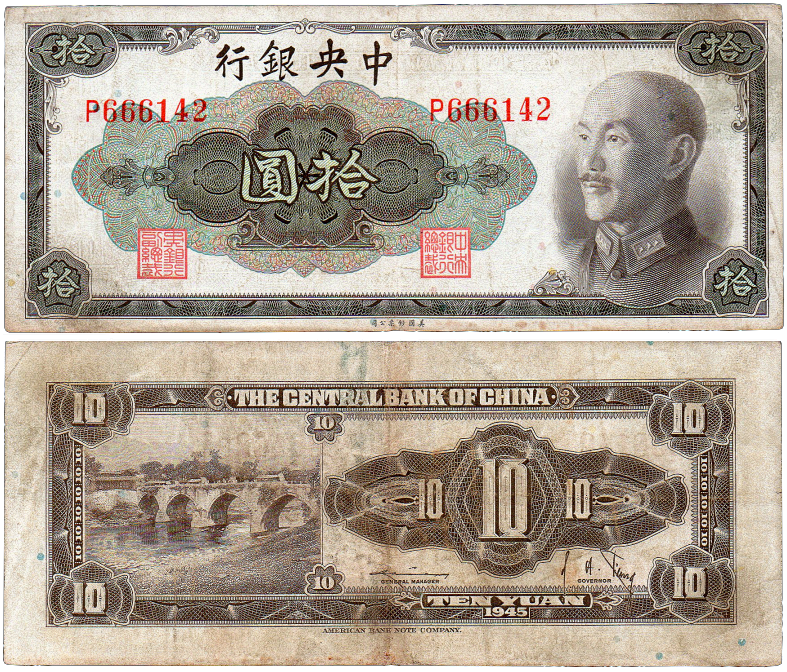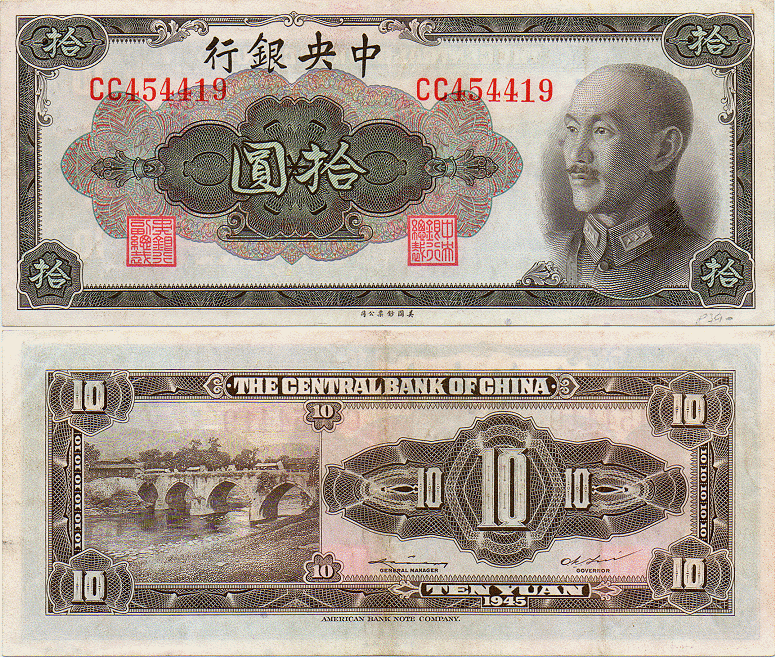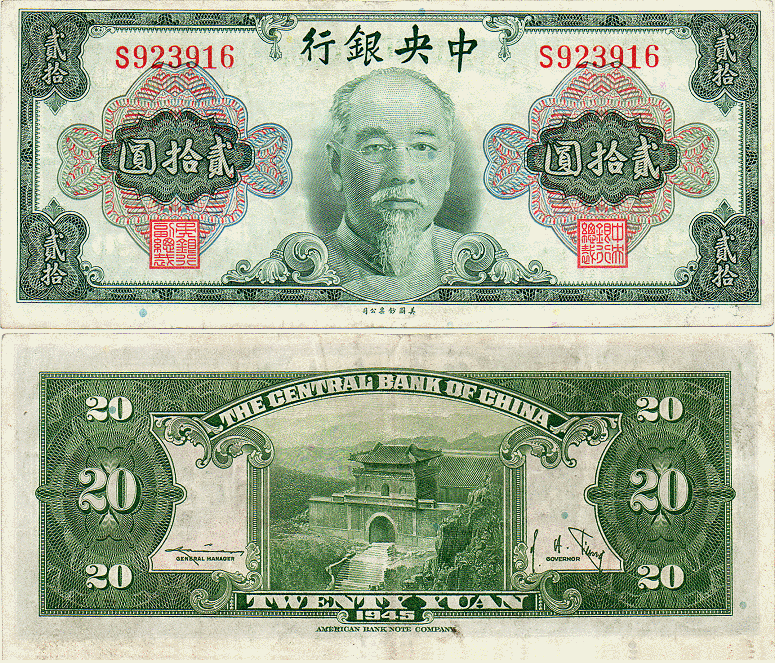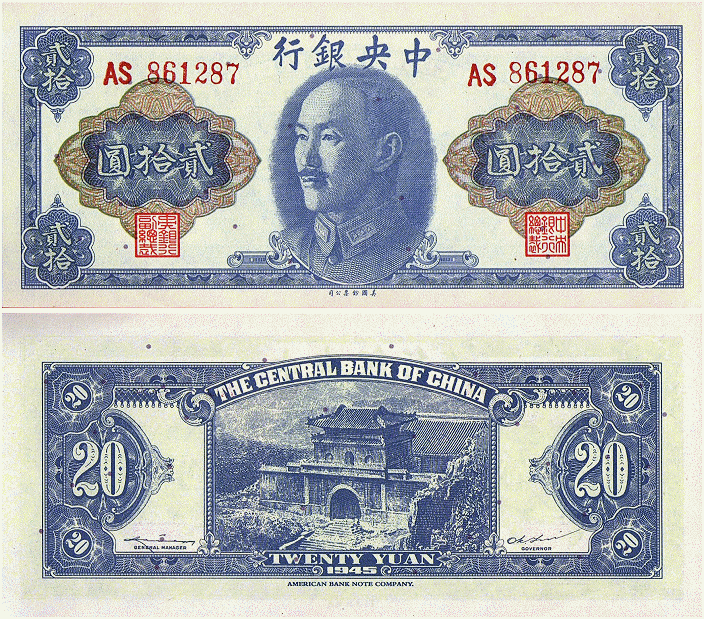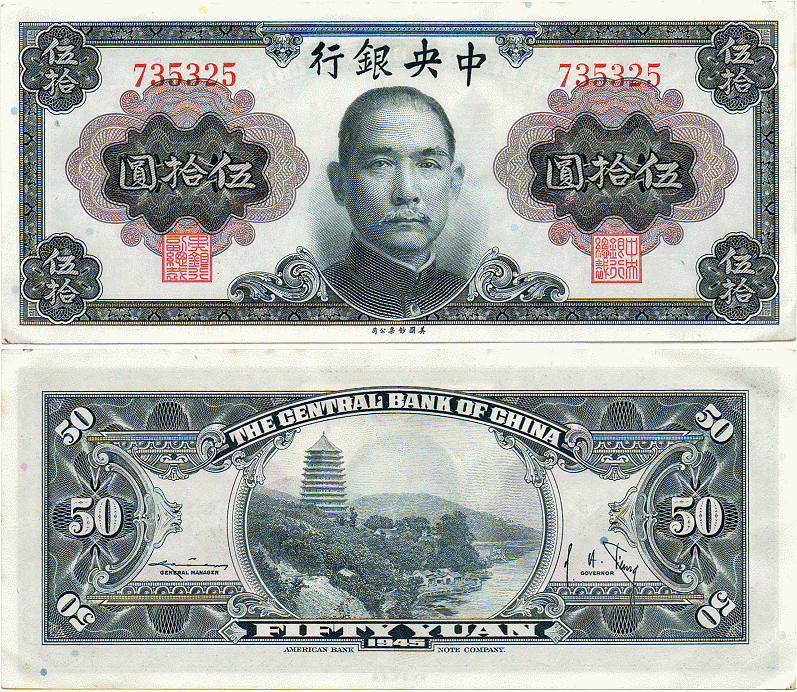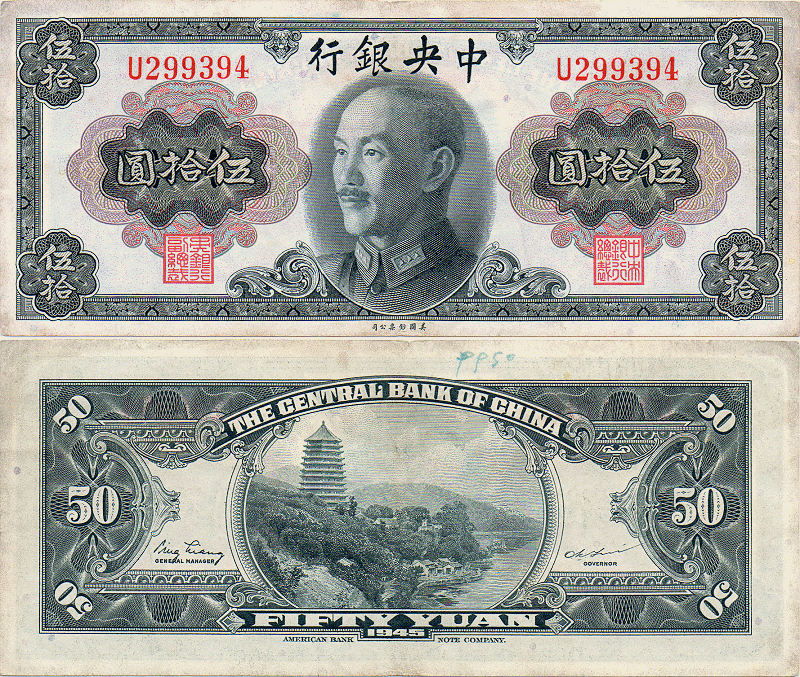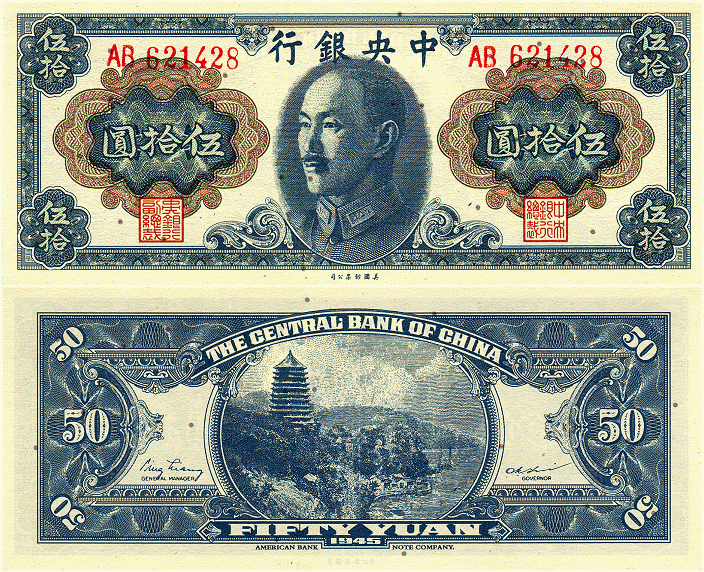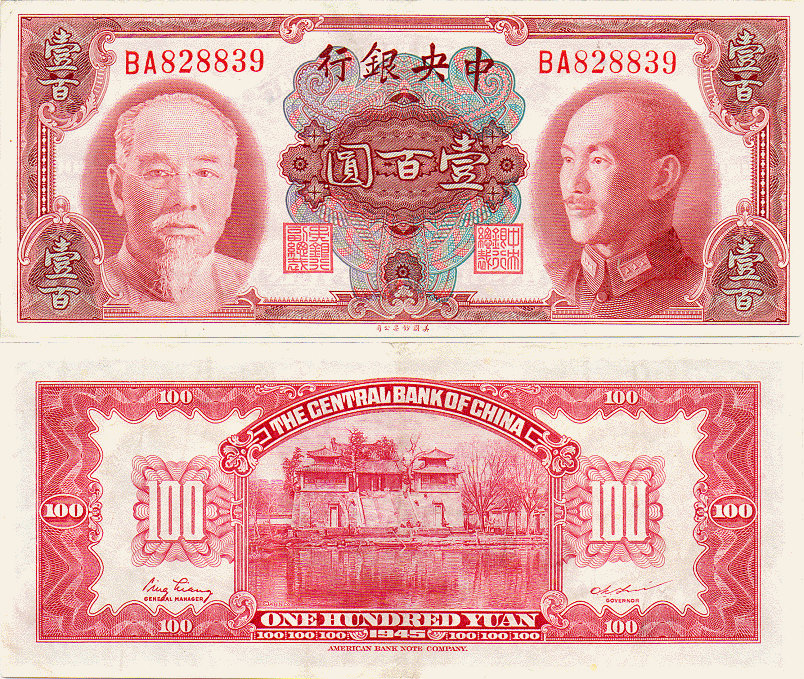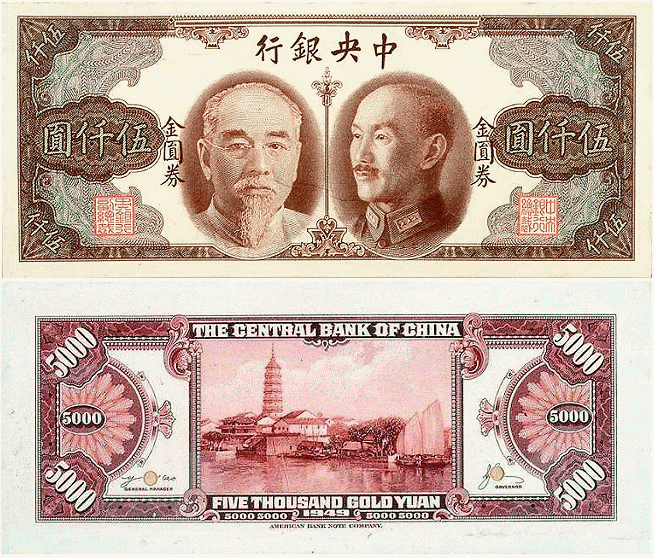The Central Bank of China series of 1945, of the American Banknote Company
A Financial Crisis
In July 1948 Chiang Kai-shek met with T. V. Soong and other senior government figures to discuss methods to stem the chaotic financial slide the occuring. The decision was made to switch to a new currency, abandoning the old fabi ('legal tender') yuan and inaugurating a gold yuan, at a conversion rate of 3 million fabi yuan to 1 new yuan. Several Guomindang advisers warned that the new currency probably could not hold firm unless the government drastically reduced its deficit spending, much of it the result of the huge military expenses to which Chiang was still committed.
After a temporary bank closure to prevent panic, all the old fabi notes were to be turned in to the banks for exchange. To inspire confidence in the new notes, the government undertook not to authorise the printing of more than 2 billion of them. Wage and price increases were forbidden, along with strikes and demonstrations. And any gold and silver bullion, along with any foreign currency, held privately by Chinese citizens were to be turned in to the banks in exchange for the new currency, thus boosting the government’s reserves of specie and foreign exchange. Inevitably however after a promising start, the new currency rapidly declined as had it's predecessor; eventually devaluing at an even greater rate.
A popular saying at the time was that "a pocket full of money could not buy a pocket full of rice."
One peculiarity of the issues of the 'new gold yuan' is that none of the banknotes have the date given in Chinese on the face of the note.
By December of 1948 however the government declared it's intention to issue permits to buy gold bars via the Central Bank of China. Soaring black market prices for gold and the worsening political situation caused a clamour with huge mobs of people gathering outside the branches to collect the permits and purchase gold. At the Shanghai branch over 30,000 people gathered, and at least seven people at the front of the queue were killed in the rush for the entrance upon the opening of the branch. Similar scenes were reported at other cities.
By May 1949 7,000,000 gold yuan was worth only 1 US dollar. This in turn led to yet another currency overhaul with the introduction of the New Silver Dollar. But it was too little, too late and by the end of the year Chiang Kai shek and his government had fled to Taiwan and Mao proclaimed the new Peoples Republic at Beijing.
The ABNco series of 1945
At the end of World War II; the Second Sino-Japanese War, The Central Bank of China contracted the New York based currency printer The American Banknote Company to design and produce a new banknote series. The end of the war brought hope for new national and financial stability and the Chinese government clearly hoped to be able to bring inflation under control. However, by the time the first batches of the new banknotes had been printed and delivered, this had not happened and it was clear that the notes would have to be withheld as the lower denominations in particular would be valueless, costing more than their face value to print and issue.
The series was retained until the plan was developed during 1948 to replace the current and collapsing 'Fabi Yuan' with a new Gold Yuan which these notes would become among the first issues of. Alongside these, the government's Central Printing Factories and the Chung Hwa Printing Co. would also issue new Gold Yuan notes.
These notes held their value well for a few months, but then rapidly declined, devaluing at an even greater rate than the old Fabi they had replaced.
At the end of World War II; the Second Sino-Japanese War, The Central Bank of China contracted the New York based currency printer The American Banknote Company to design and produce a new banknote series. The end of the war brought hope for new national and financial stability and the Chinese government clearly hoped to be able to bring inflation under control. However, by the time the first batches of the new banknotes had been printed and delivered, this had not happened and it was clear that the notes would have to be withheld as the lower denominations in particular would be valueless, costing more than their face value to print and issue.
The series was retained until the plan was developed during 1948 to replace the current and collapsing 'Fabi Yuan' with a new Gold Yuan which these notes would become among the first issues of. Alongside these, the government's Central Printing Factories and the Chung Hwa Printing Co. would also issue new Gold Yuan notes.
These notes held their value well for a few months, but then rapidly declined, devaluing at an even greater rate than the old Fabi they had replaced.
The Banknotes
Despite the slight information supplied in catalogues; one thing is clear: not all of this ABNco printed money of 1945 was printed at that time and withheld. Clearly the company was instructed to resume printing the money in 1948, and with some new denominations and modified designs.
The signature varieties found on many of the notes are the most obvious indicator of this. It is clear that the blue 1 Yuan was not among the first issue of this series, but was added in 1948 as unlike the 10 Yuan, there are no signature variants. Equally there was assumedly little demand for the $20 denomination as these only appear with the first signature type.
A blog dedicated to the output of the Hong Kong Printing Press (official blog?) indicates an interesting possibility based on letter's with enclosed samples - that some of the '1945' ABNC series of notes may have been printed by the Hong Kong Printing Press, subcontracted by the ABNC:
https://hkprintingpress.wordpress.com/tag/china-bank/
Despite the slight information supplied in catalogues; one thing is clear: not all of this ABNco printed money of 1945 was printed at that time and withheld. Clearly the company was instructed to resume printing the money in 1948, and with some new denominations and modified designs.
The signature varieties found on many of the notes are the most obvious indicator of this. It is clear that the blue 1 Yuan was not among the first issue of this series, but was added in 1948 as unlike the 10 Yuan, there are no signature variants. Equally there was assumedly little demand for the $20 denomination as these only appear with the first signature type.
A blog dedicated to the output of the Hong Kong Printing Press (official blog?) indicates an interesting possibility based on letter's with enclosed samples - that some of the '1945' ABNC series of notes may have been printed by the Hong Kong Printing Press, subcontracted by the ABNC:
https://hkprintingpress.wordpress.com/tag/china-bank/

